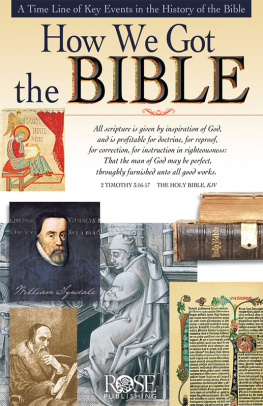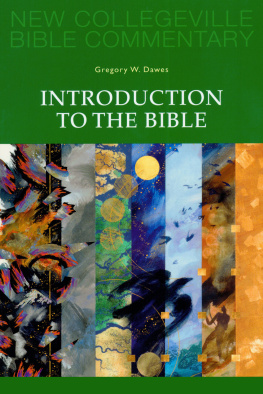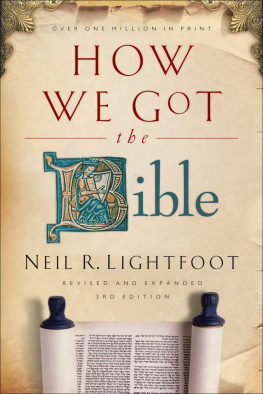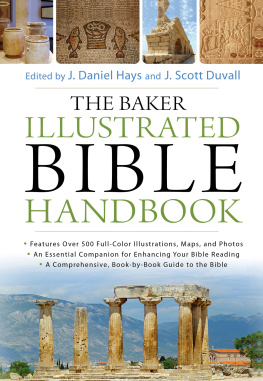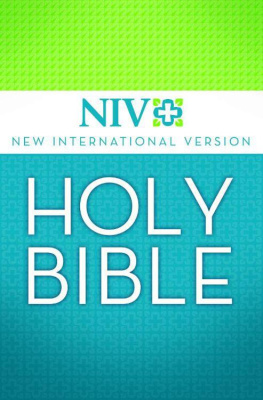Dr. Stephen Dempster (Atlantic Baptist University): The Production and Shaping of the Old Testament Canon
Dr. J. Scott Duvall (Ouachita Baptist University): Bible Translations and the English Bible
Dr. Bryan Harmelink (SIL International): Translations for the World
Dr. Karen H. Jobes (Wheaton College): The Septuagint
Dr. C. Marvin Pate (Ouachita Baptist University): The Dead Sea Scrolls
Dr. M. James Sawyer (Western Seminary): The Canon of the New Testament
Dr. Mark L. Strauss (Bethel Seminary): The Inspiration of the Bible
Dr. Daniel B. Wallace (Dallas Theological Seminary): Writing, Copying, and Transmitting the New Testament Text
The Inspiration of the Bible
Mark L. Strauss
Introduction
At its most fundamental level, the doctrine of inspiration means that the Bible is not merely human reflections about God or meditations on religious themes. It is rather divine communicationGods message to human beings. Inspired does not mean merely inspiring or inspirational in the way that a great work of literature or a piece of art is inspiring. It means that God himself has spoken and has disclosed himself to his people.
The Scriptural Basis for Inspiration
Scripture attests to its own inspiration both directly and indirectly. The Old Testament law is to be obeyed because its imperatives come from God himself. On Mount Sinai Moses receives the word of the L ord and delivers it to the people. The Ten Commandments begin with the affirmation, And God spoke all these words (Exod. 20:1). Consider these statements from the great acrostic Psalm 119, a celebration of the precepts, commands, and statutes that God gave to his people:
119:4You have laid down precepts that are to be fully obeyed.
119:13With my lips I recount all the laws that come from your mouth.
119:86All your commands are trustworthy.
119:88I will obey the statutes of your mouth.
119:89Your word, O L ord , is eternal; it stands firm in the heavens.
119:138The statutes you have laid down are righteous; they are fully trustworthy.
119:152Long ago I learned from your statutes that you established them to last forever.
Gods word is faithful and true because it comes from the mouth of the one who is Faithful and True (Rev. 19:11).
Scripture as Gods own self-revelation is equally affirmed in the prophets, where God speaks through his human servants. The formula, the word of the L ord came to... appears throughout the prophetic corpus (Jer. 1:2; Hosea 1:1; Jon. 1:1; Mic. 1:1; Zeph. 1:1; Hag. 1:1; Zech. 1:1; cf. Luke 3:2). The first chapter of Isaiah illustrates well the multiplicity of expressions: the L ord has spoken (Isa. 1:2); hear the word of the L ord (1:10); says the L ord (1:11); for the mouth of the L ord has spoken (1:20); the Lord, the L ord Almighty, the Mighty One of Israel, declares (1:24). The prophets confirm that inspiration is the convergence of the human and the divine. Jeremiahs prophecies are simultaneously the words of Jeremiah son of Hilkiah and the word of the L ord (Jer. 1:12). This convergence is especially clear in quotations of the Old Testament in the New. New Testament writers easily move back and forth referring to Scripture as the words of the human prophet (this is what was spoken by the prophet Joel; Acts 2:16, citing Joel 2:2832) or a message given directly by the Holy Spirit (So, as the Holy Spirit says; Heb. 3:7, citing Ps. 95:7; see also Heb. 10:1517, citing Jer. 31:33, 34). The prayer of the church in Acts 4 provides the fullest description: You [God] spoke by the Holy Spirit through the mouth of your servant, our father David (Acts 4:25; citing Ps. 2:1, 2). God spoke by means of the Spirit through his human agent.
Scriptures inspiration, affirmed implicitly in these passages, finds explicit expression in 2 Timothy 3:1617:
All Scripture is God-breathed and is useful for teaching, rebuking, correcting and training in righteousness, so that the man of God may be thoroughly equipped for every good work.
The Greek word translated God-breathed is theopneustos , a term possibly coined by Paul himself to express the nature of inspiration. The King James Version rendering, inspired by God, finds it roots in the Latin Vulgate ( divinitus inspirata ). Unfortunately in -spired might suggest that God breathed into Scripture its authority, while theopneustos more likely means that God breathed out Scripture. Inspiration does not mean divine validation of a human work, but Gods self-revelation of his own purpose and will. Second Timothy 3:16 further affirms that the purpose of inspiration is to enable Gods people to live in right relationship with God (training in righteousness) and with others (equipped for every good work). The Bible is not an icon to be worshiped or an oracle to be consulted. It is rather a living account of Gods actions in human history and a practical guidebook for living as the people of God.
Second Peter 1:21 provides further insight into the process of inspiration: For prophecy never had its origin in the human will, but prophets, though human, spoke from God as they were carried along by the Holy Spirit (TNIV). While this passage again confirms the divine-human origin of Scripture, it expressly concerns the prophets, who often received oracles and visions directly from God, and so may not be a definitive expression of the manner and means of inspiration. What does it mean, for example, that the prophets were carried along by the Holy Spirit? While the precise mode of inspiration remains a mystery, the following clarifications can be made.
Clarifications Related to Inspiration
How can texts written by ordinary human beings in the context of common human experience be at the same time the eternal and unchanging Word of God? The following points seek to clarify the nature of inspiration.
Inspiration Is Not Dictation
Except in some specialized cases, inspiration does not mean dictation. God did not whisper into the ears of the biblical authors, but rather worked through each authors own circumstances, thoughts, intentions , and personalities to communicate his divine message. The exceptions would be in those cases where the author is told to write exactly what he is told (as in some prophetic texts) or where God himself inscribes the text (as in the Decalogue, inscribed on stone tablets by the finger of God; Exod. 31:18). Evidence that inspiration does not mean dictation is the differences among biblical authors in literary styles, including vocabulary choice, sentence structure, level of diction, and choice of genre. Marks Gospel, for example, is written in a rather rough Semitic style, with a great deal of parataxis (parallel sentences linked by and), while Lukes has a more refined Hellenistic literary style.




